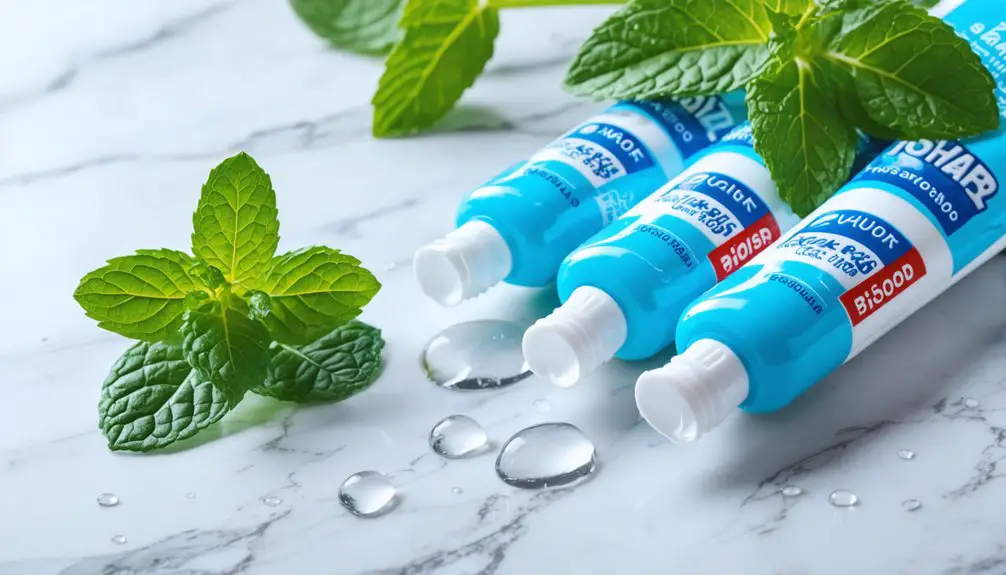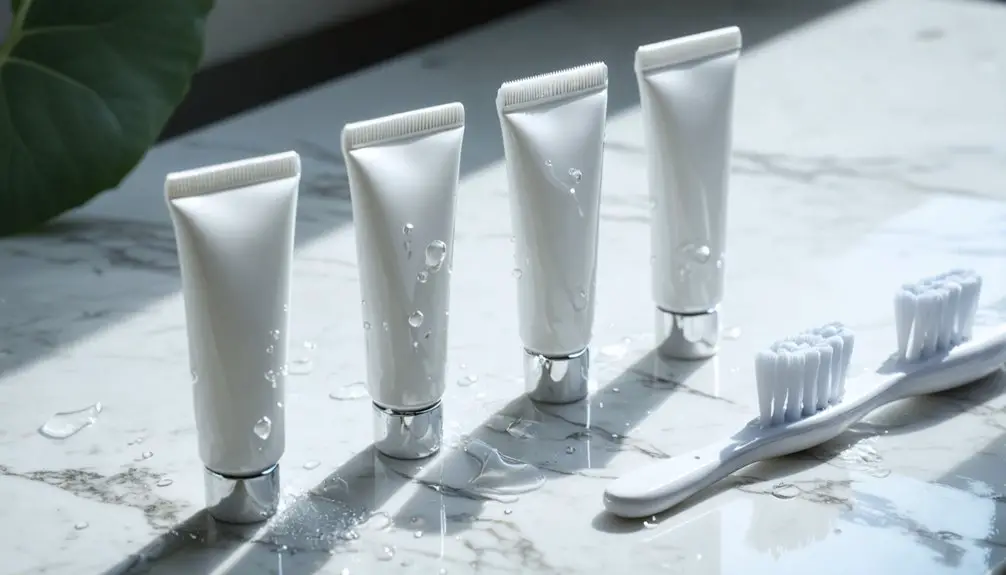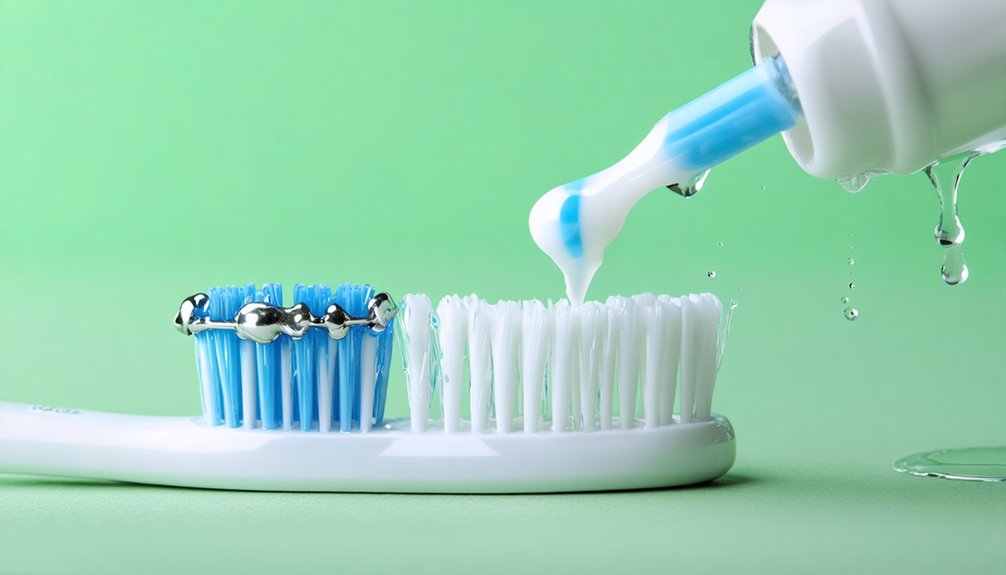While microbead toothpaste remains available, you’ll need to take precautions to protect your health and the environment. Check labels for polyethylene and polypropylene, brush gently at a 45-degree angle to prevent gum embedding, and dispose of waste in tissues rather than rinsing down drains. Install sink strainers, monitor your gums for irritation, and consider switching to natural alternatives with jojoba wax or rice bran. Our extensive guide offers essential strategies for safer microbead toothpaste use.
Key Takeaways
- Brush with light pressure (150-200 grams) at a 45-degree angle using circular motions to prevent forcing microbeads into gum tissue.
- Check ingredient lists for polyethylene, polypropylene, and polymethyl methacrylate before purchasing toothpaste containing microbeads.
- Install a fine-mesh sink strainer to catch microbeads and dispose of toothpaste in tissue rather than rinsing down drain.
- Monitor gums regularly for irritation or embedded blue particles, and schedule dental cleanings for professional removal if necessary.
- Use an electric toothbrush with pressure sensor to maintain controlled force and minimize potential microbead-related gum damage.
Understanding What’s Really in Your Microbead Toothpaste
While many consumers assume toothpaste is a simple blend of cleaning agents, the reality is that some formulations contain microscopic plastic particles called microbeads.
These plastic additives, primarily made of polyethylene, polymethyl methacrylate, and polypropylene, can comprise up to 7.24% of your toothpaste’s weight.
You’ll often spot microbeads as colorful specks or glittering spheres in your toothpaste. Despite their decorative appeal, these particles have sparked significant environmental impact concerns, leading to microbead regulation like the U.S. Microbead-Free Waters Act. These tiny particles are particularly concerning as they harm marine wildlife by entering waterways. Natural alternatives like ground fruit seeds are becoming more common in toothpaste formulations.
When checking ingredient labels, look for terms like polyethylene, carbomer, and polyvinylpyrrolidone (PVP) to identify microplastic content.
It’s worth noting that not all toothpastes contain these additives – roughly 40% of dental care products are microbead-free.
Checking Labels for Hidden Microplastic Ingredients
How can you identify hidden microplastics in your toothpaste when manufacturers use complex terminology? Start by scanning ingredient lists for polyethylene (PE), polypropylene (PP), polymethyl methacrylate (PMMA), and polyethylene terephthalate (PET).
Don’t be misled by generic terms like “synthetic polymers” or “plastic particles” – these often mask microplastic content.
Label transparency varies greatly between brands and regions. You’ll need to look beyond marketing claims and examine detailed ingredient lists, as microplastics can appear in different forms – from visible microbeads to less obvious fibers or liquid polymers. These microplastics have been found in 80% of bloodstreams in recent studies.
While some manufacturers have phased out microbeads, other microplastic forms remain prevalent, with studies showing 87% of cosmetic products still contain them. These microplastics can bypass water filters and enter natural waterways.
Enhance your ingredient awareness by recognizing that microplastics might comprise between 0.2% to 7.24% of your toothpaste’s weight.
Protecting Your Gums While Using Microbead Products
When using microbead toothpaste, you’ll need to monitor your gums closely for signs of irritation, inflammation, or visible plastic particles becoming trapped along the gumline.
You should maintain gentle brushing pressure to prevent forcing microbeads into your gum tissue, as trapped particles can create pockets where bacteria accumulate. Dental hygienists frequently discover microbeads embedded in patients’ gums during routine cleanings.
According to dental data, 20 percent of patients have been found to have embedded microbeads in their gum tissue. If you notice any discomfort or changes in your gum health, it’s crucial to reduce your brushing pressure and consider switching to a microbead-free alternative.
Watch For Gum Irritation
Since microbeads can become lodged in your gum line and sulci, it’s crucial to monitor for signs of gum irritation when using microbead toothpaste products.
These plastic particles may remain trapped undetected while compromising your gum health and oral hygiene. No healthcare benefit exists from using toothpaste containing microbeads, as they serve only decorative purposes.
Major manufacturers like Procter & Gamble have pledged to discontinue using microbeads due to safety concerns.
Watch for these warning signs:
- Blue spots visible underneath your gums, which indicate trapped microbeads
- Increased bleeding or discomfort while brushing
- Swollen, tender, or inflamed gum tissue
- Development of periodontal pockets between teeth and gums
If you notice any of these symptoms, consult your dental professional immediately.
The trapped particles can create breeding grounds for bacteria, potentially leading to gingivitis or more serious periodontal conditions.
Your hygienist can properly examine and address any embedded microbeads during your cleaning appointment.
Minimize Brushing Pressure Daily
Using the right amount of pressure while brushing with microbead toothpaste is critical to protect your gum health and prevent tissue damage.
Maintain pressure awareness by applying only 150-200 grams of force – about the weight of an orange. This gentle approach prevents microbeads from embedding into your gums and creating harmful micro-pockets.
Your brushing technique should incorporate a 45-degree angle to the gum line with short, circular strokes. The blue plastic particles in some toothpastes can cause increased enamel wear if too much force is applied.
Consider switching to an electric toothbrush with a pressure sensor to monitor your force. Choose a soft-bristled brush with a head size that fits comfortably in your mouth for controlled cleaning. While the FDA approves these particles for use in dental products, many consumers prefer alternatives for environmental reasons.
Safe Disposal Methods to Minimize Environmental Impact
To protect waterways from microbead pollution, you’ll need to avoid rinsing toothpaste directly down the drain and instead wipe excess product onto a tissue for disposal in regular trash.
When you’re finished with your toothpaste tube, separate the plastic and aluminum components for proper recycling through your local waste management program.
You can further minimize environmental impact by installing a fine-mesh sink strainer to catch any accidental microbead discharge before it enters the water system.
Proper Sink Filtration Methods
Three essential components form the foundation of proper sink filtration when disposing of microbead-containing products: membrane filters, advanced water filtration systems, and dedicated catchment devices.
You’ll need to implement specific filtration techniques to prevent microbeads from entering waterways.
- Install a pre-filtration sieve to capture particles larger than 5mm, followed by membrane filters with appropriate pore sizes.
- Set up a multi-stage filtration system incorporating reverse osmosis and activated carbon technology for 99% microbead removal.
- Position dedicated catchment filters at sink drain outlets to trap microbeads before wastewater entry.
- Maintain regular cleaning schedules for all filters to prevent overflow and guarantee peak performance.
For maximum effectiveness, combine these methods with sedimentation pre-treatment to aggregate heavier particles before they enter your filtration system.
Eco-Friendly Container Recycling
While conventional toothpaste tubes pose significant recycling challenges, proper disposal methods can minimize their environmental impact. You’ll find specialized toothpaste tube recycling programs, like TerraCycle, that safely process multi-material packaging. Instead of tossing tubes in regular trash, participate in these mail-back or take-back initiatives.
Look for eco-friendly packaging marked with “Recycle Me!” symbols and check if your local facility accepts the material. Before recycling, compress tubes to conserve bin space.
If your community doesn’t process toothpaste tubes, seek recycling events specifically handling oral care waste. Choose brands committed to recyclable packaging, and avoid formulations containing microbeads.
Remember not to flush toothpaste down sinks or toilets, as this releases harmful microplastics into waterways.
Recognizing Signs of Gum Irritation From Microbeads
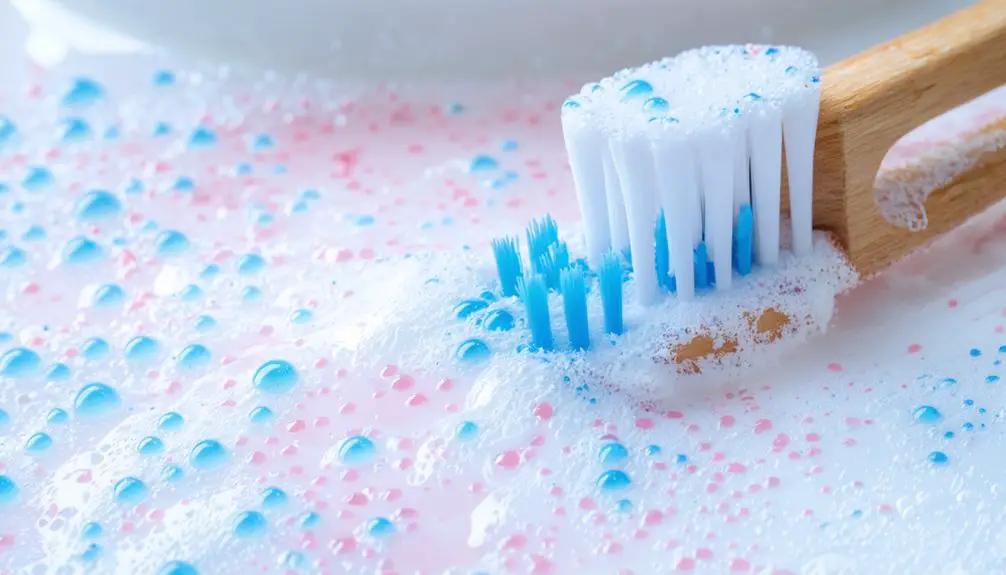
Since microbeads can lodge themselves in gum tissue during brushing, recognizing signs of gum irritation is crucial for protecting your oral health.
Gum inflammation awareness starts with monitoring your oral tissues for key warning signals that indicate microbead accumulation. Through proper microplastic detection techniques, you’ll be able to identify potential issues before they become severe.
Watch for these critical signs:
- Blue plastic particles visible in gum pockets around teeth
- Swollen, tender, or bleeding gums during brushing and flossing
- Formation of deeper periodontal pockets beyond 3mm
- Persistent gum discomfort localized to specific areas
If you notice any of these symptoms, consult your dental professional immediately. Early detection and intervention can prevent more serious periodontal complications from developing.
Exploring Natural and Eco-Friendly Alternatives
You’ll find that natural ingredients like baking soda and coconut oil provide effective cleaning power without the environmental concerns of plastic microbeads.
Sustainable packaging innovations, including recyclable tubes and glass containers, offer practical solutions to reduce plastic waste in your oral care routine.
Biodegradable alternatives, such as herbal tooth powders and clay-based formulas, can effectively clean your teeth while ensuring that no harmful microplastics enter water systems.
Natural Cleaning Ingredients Work
Recent clinical studies have demonstrated that natural cleaning ingredients in toothpaste can match or exceed the effectiveness of synthetic alternatives.
You’ll find that eco-friendly alternatives like chamomile and green tea extracts provide powerful anti-inflammatory and antibacterial properties without harsh chemicals.
- Natural ingredients such as arnica montana and echinacea purpurea effectively reduce plaque buildup while supporting your oral microbiome.
- Plant-based compounds like Rhizoma chuanxiong help decrease gingival bleeding by targeting inflammatory pathways.
- Theobromine from cacao strengthens tooth enamel comparable to fluoride.
- Herbal formulations exclude sodium lauryl sulfate and carrageenan, preventing mucosal irritation.
These natural cleaning agents adsorb to your enamel, delivering bacteriostatic and bactericidal effects similar to conventional options while maintaining oral health safely and effectively.
Sustainable Packaging Solutions Matter
While traditional toothpaste packaging contributes considerably to plastic pollution, sustainable alternatives are altering the oral care industry.
You’ll find innovative options like recyclable mono-material plastic tubes and metal alternatives that reduce environmental impact. FSC-certified recycled board boxes and tree-free materials including bamboo, hemp, and sugarcane offer eco-friendly packaging solutions.
For maximum sustainability, consider switching to toothpaste tablets packaged in glass jars, tins, or compostable bio-resin containers. These zero-waste options eliminate the need for plastic tubes entirely.
You can further minimize waste by choosing refillable packaging systems with compostable tablet pouches. Major manufacturers like Colgate are adapting to recyclable HDPE tubes, while emerging innovations like Coolpaste demonstrate the industry’s commitment to sustainable packaging without compromising product integrity.
Biodegradable Options Beat Microbeads
Beyond sustainable packaging, the movement toward eco-friendly oral care extends to the ingredients themselves. When choosing your toothpaste, you’ll find remarkable biodegradable benefits in natural alternatives that outperform traditional plastic microbeads. These eco-friendly innovations protect both your dental health and the environment.
- Cellulose-based microbeads break down into harmless sugars, eliminating toxic impacts on marine ecosystems and the food chain.
- Jojoba beads provide effective exfoliation while naturally melting at higher temperatures, ensuring complete biodegradation.
- Plant-derived alternatives are produced through sustainable manufacturing processes that achieve price parity with conventional options.
- Natural microbeads from renewable sources meet strict regulatory standards while delivering the same cleaning effectiveness you expect.
These biodegradable options represent the future of responsible oral care, supporting both your health and environmental stewardship.
Making the Switch to Microbead-Free Options
Since the global push to eliminate microbeads from personal care products continues to gain momentum, making the switch to microbead-free toothpaste options has become increasingly important for both environmental and health reasons.
As microbead regulations tighten worldwide, you’ll find numerous sustainable ingredients that provide effective alternatives. Look for toothpastes containing natural abrasives like silica, calcium carbonate, or sea salt. These ingredients deliver comparable cleaning power while protecting marine ecosystems.
When shopping, carefully examine product labels for microplastic synonyms such as microspheres or polyethylene. Choose brands that prioritize eco-friendly packaging alongside their natural formulations.
Maximizing Oral Health Despite Microbead Risks
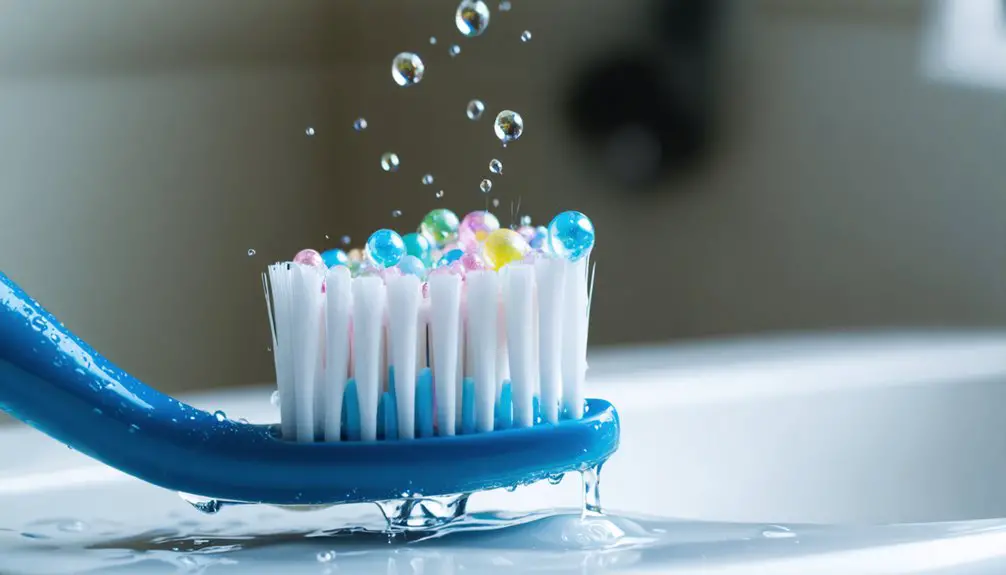
To safeguard your oral health against microbead risks, implementing targeted hygiene strategies remains essential even as these plastic particles persist in some dental products.
Focus on extensive oral care practices while seeking microbead alternatives to minimize potential harm.
- Brush gently but thoroughly twice daily using a powered toothbrush with timer to guarantee peak cleaning without damaging gum tissue.
- Incorporate daily flossing and interdental cleaning tools to dislodge trapped microbeads from hard-to-reach spaces.
- Use antimicrobial rinses to combat bacterial growth in areas where microbeads may accumulate.
- Schedule regular professional cleanings to remove embedded microbeads and prevent periodontal complications.
These practices help maintain oral health while you shift to safer microbead-free products, protecting both your wellbeing and the environment through conscientious oral hygiene habits.
Preventing Microbead Accumulation in Gum Pockets
While microbeads remain a concerning component in some dental products, you can actively prevent their accumulation in gum pockets through targeted preventive measures.
Start by switching to microbead-free toothpaste options, particularly those with the ADA Seal of Acceptance. To protect your patients’ gum health, recommend gentle brushing techniques that don’t force particles into the sulcus area around teeth.
Regular dental check-ups are essential for early detection of blue plastic particles in gum pockets.
Enhance your microbead awareness by examining product labels carefully and choosing pyrophosphate-based alternatives for tartar control.
When treating patients who’ve used microbead toothpaste, schedule deep cleaning procedures to remove any trapped particles, preventing potential inflammation and periodontal disease development.
Supporting Sustainable Dental Care Practices
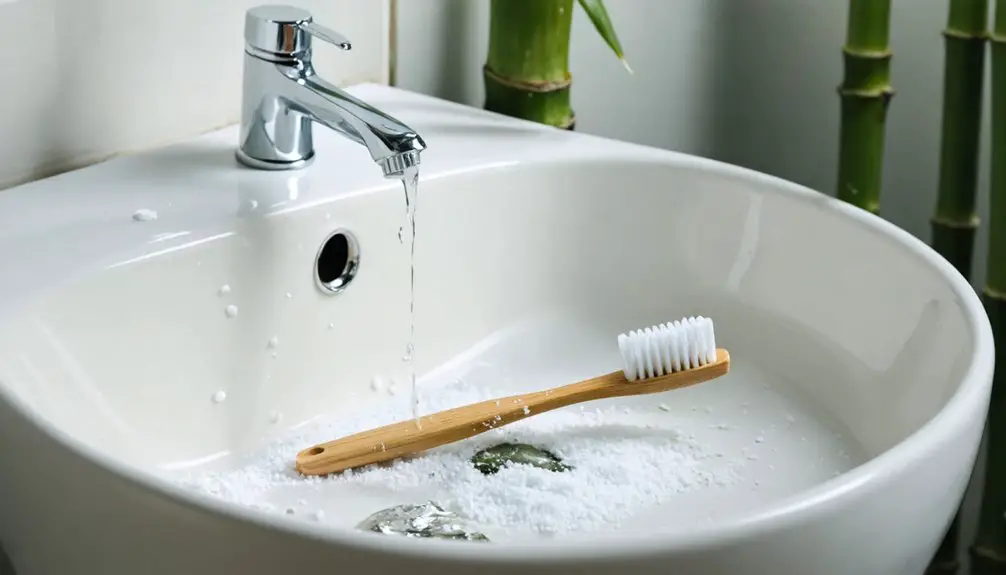
Moving beyond individual patient care, sustainable dental practices represent a broader commitment to environmental stewardship.
As microbead regulations continue to evolve, you’ll need to adapt your dental care routines to support environmentally conscious choices.
- Choose toothpastes with natural exfoliants like jojoba wax, rice bran, or baking soda instead of products containing synthetic microbeads.
- Look for dental products in recyclable, compostable, or refillable packaging to reduce waste.
- Support brands that have voluntarily phased out microbeads and adopted sustainable practices in their manufacturing.
- Select biodegradable alternatives that won’t harm aquatic ecosystems or contribute to microplastic pollution.
Frequently Asked Questions
Can Children Use Microbead Toothpaste Safely?
You shouldn’t let children use microbead toothpaste due to child safety concerns and lack of dental health benefits. While not acutely toxic, microbeads can embed in gums and pose environmental risks.
How Long Do Microbeads Stay Trapped in Gums After Switching Toothpaste?
While you’ll notice improvement in gum health after switching toothpaste, trapped microbeads can persist for months. They don’t dissolve naturally, and you’ll need regular dental cleanings to fully remove them.
Will Professional Teeth Cleaning Remove Embedded Microbeads From Gums?
Professional cleaning won’t fully remove microbeads deeply embedded in your gums. While surface beads may dislodge during cleaning, you’ll likely need specialized procedures to address persistent microbead effects impacting your gum health.
Do Whitening Toothpastes Contain More Microbeads Than Regular Formulations?
While you’d expect superior whitening effectiveness, studies haven’t conclusively proven whitening toothpastes contain more microbeads. However, they’re more likely to include them as abrasive agents for stain removal.
Can Microbeads Cause Allergic Reactions or Sensitivity to Certain Foods?
While microbeads aren’t direct allergens, they can damage your oral mucosa, potentially triggering allergic reactions and food sensitivity. Their abrasive nature may disrupt your mouth’s protective barrier, increasing discomfort with certain foods.
References
- https://pmc.ncbi.nlm.nih.gov/articles/PMC10838805/
- https://meadowsfamilydentistry.com/blog/dangers-polyethylene-beads-toothpaste
- https://pmc.ncbi.nlm.nih.gov/articles/PMC10372460/
- https://wesmyle.com/blogs/blog/toothpaste-without-microplastics
- https://www.beverlyhillsladentist.com/blog/microbeads-toothpaste-face-wash/
- https://www.hinsdaledental.com/blog/5-toothpaste-ingredients-to-avoid/
- https://www.fleeck.com/blogs/plastic-in-toothpastes-the-best-toothpaste-without-microplastics/
- https://www.7daydental.com/beware-of-microbeads-in-your-toothpaste/
- https://www.beatthemicrobead.org/myth-buster-toothpaste-still-contains-plastic-ingredients/
- https://www.oceancommunitychallenge.com/post/microplastics-in-toothpaste-a-hidden-threat-to-our-oceans-and-health

